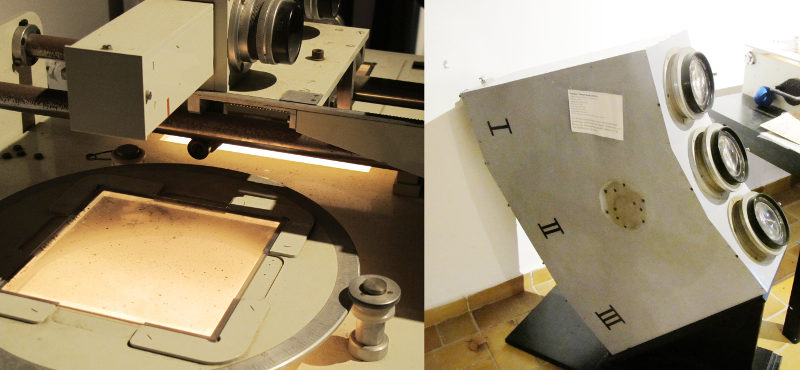Small Telescopes, Large Surveys

Plate technology at Bamberg observatory: a blink comparator with one plate mounted, and a survey camera that was once used at Boyden Station, an astronomer outpost in 60ies South Africa.
I'm currently at the workshop “Large surveys with small telescopes: past, present, and future” (or Astroplate III for short) in Bamberg, where people are discussing using and re-using the rich heritage of historical observations (hence the “plate” part) as well growing that heritage in the age of large CCDs, fast computers and large disks.
Using and re-using is of course what the Virtual Observatory is about, and we've been keeping fairly large plate collections in our data center for quite a while (among them the Archives of Landessternwarte Königstuhl or the Palomar-Leiden Trojan surveys, and there is the WFPDB TAP-accessibly). Therefore, people from GAVO Heidelberg have been to all past astroplate conferences.
For this one, I brought a brand-new tutorial on plate scans in the VO, which, I hope, also works as a general introduction to image discovery in the VO using SIAP, Datalink, and Obscore. If you're doing image stuff now and then, please have a quick look at the thing – I am particularly grateful for hints on what to improve or perhaps particularly obvious use cases for the material discussed.
Such VO proselytising aside, the conference is discussing the wide variety of creative, low-cost data collectors out there as well as computer-aided re-analysis extracting new knowledge from decades-old data. If I had to choose a single come-to-think-of-it moment, it would be Norbert Zacharias' observation that if you have a well-behaved object and you'd like to know where it was in 1900, it's now more accurate to extrapolate Gaia astrometry to the epoch of observation than to measure it on the plate itself. Which is saying a lot about the amazing feat of engineering that Gaia is.
This is not, however, an argument for dumping the old data. Usually, it is exactly what is not so well-behaved (like those) that's interesting – both in terms of astrometry and in terms of photometry (for which there's a lot more unruly behaviour in the first place). To figure out how objects don't behave well, and, for objects disguising as well-behaved only on time scales of the (say) Gaia mission, which these are, the key is “old” data. The freshness of which we're discussing this week.

![[RSS]](../theme/image/rss.png)